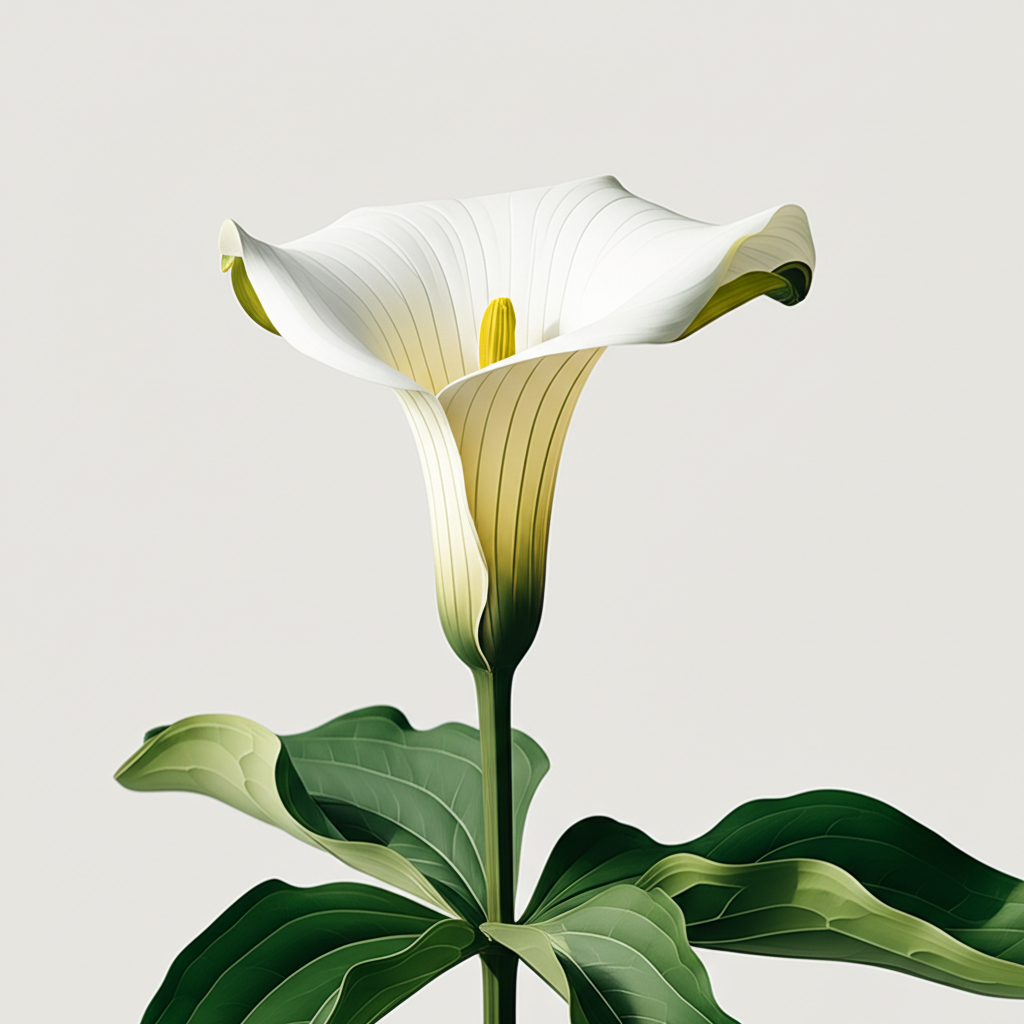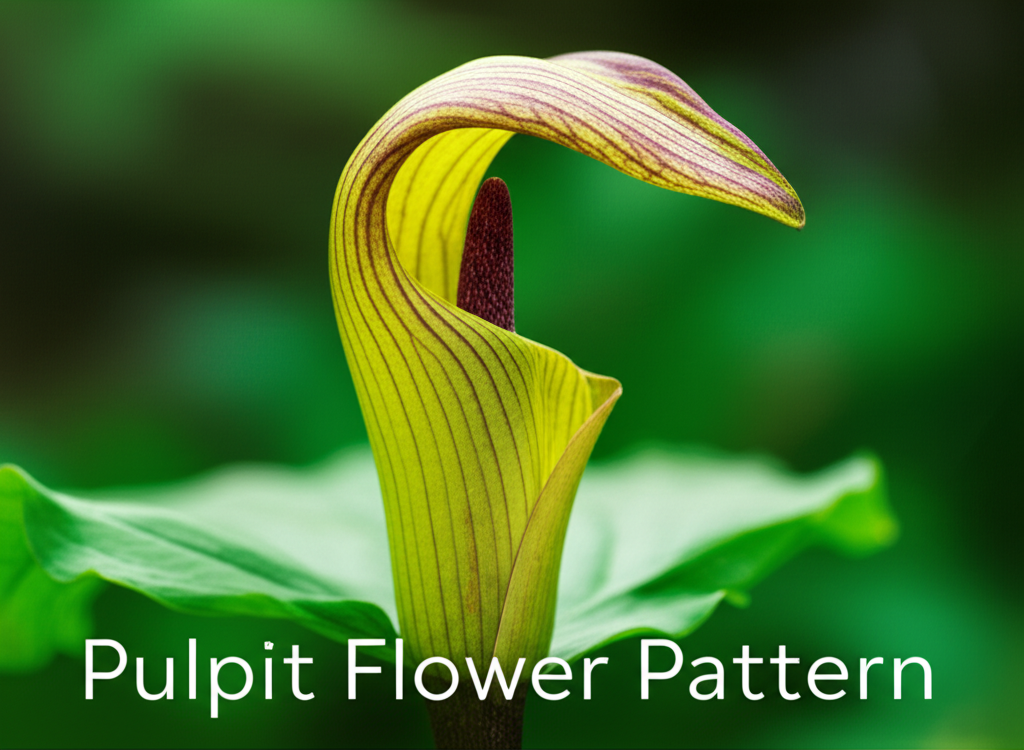Introduction: The Allure of the Jack-in-the-Pulpit
The Jack-in-the-Pulpit (Arisaema triphyllum) is a fascinating woodland wildflower native to eastern North America. Its distinctive appearance, resembling a preacher in a pulpit, has captivated botanists and nature enthusiasts for centuries. Beyond its striking visual appeal, the plant exhibits a complex and intriguing flowering pattern that has been the subject of considerable scientific study. This article delves into the intricate details of how the Jack-in-the-Pulpit reproduces, the factors influencing its floral development, and the remarkable plasticity it displays in its reproductive strategies. Understanding these patterns is crucial for appreciating the ecological role of this iconic plant and for its conservation.
The Anatomy of a Jack-in-the-Pulpit Flower

Before exploring its flowering pattern, it’s essential to understand the unique morphology of the Jack-in-the-Pulpit. The plant’s common name derives from its characteristic inflorescence, which consists of several key parts:
- Spathe: This is the prominent, hood-like structure that encloses the floral column. It is often green with purple or brown stripes, though color variations exist. The spathe serves to protect the developing flowers and attract pollinators.
- Spadix: This is the central, club-shaped or finger-like structure that emerges from the spathe. It is covered in numerous tiny, unisexual flowers. The tip of the spadix, known as the appendix, is typically sterile and can vary in shape and size.
- Leaves: Typically, mature Jack-in-the-Pulpit plants bear two trifoliate leaves. The arrangement and size of these leaves are often indicative of the plant’s reproductive status.
Understanding the Reproductive Strategy: Sequential Monoecy
One of the most remarkable aspects of the Jack-in-the-Pulpit is its reproductive strategy, known as sequential monoecy or gerontomorphic sex change. This means that a single plant can change its sex over its lifetime.
From Male to Female: The Developmental Trajectory
Jack-in-the-Pulpit plants typically begin their reproductive lives as functionally male. This is an evolutionary advantage as it allows younger, smaller plants with less stored energy to invest in producing pollen, which requires less metabolic effort than producing seeds.
- Younger, Smaller Plants: These plants are generally male. They produce an inflorescence with a preponderance of male flowers and fewer, or sometimes no, female flowers.
- Mature, Larger Plants: As the plant grows larger and accumulates more resources, it often transitions to becoming functionally female. This allows these more robust plants to invest in producing the energy-rich berries that develop from fertilized female flowers.
Environmental Influences on Sex Determination
While age and size are primary drivers of sex change, environmental factors can also play a significant role.
- Resource Availability: Adequate sunlight, water, and nutrient availability contribute to robust growth, increasing the likelihood of a plant transitioning to a female phase.
- Competition: Plants growing in highly competitive environments may remain in the male phase for longer, prioritizing survival and pollen dispersal.
- Damage and Stress: Significant damage to a plant, such as from herbivory or harsh weather, can sometimes trigger a reversion to the male phase, or prevent it from transitioning to female.
The Flowering Pattern: A Detailed Look
The flowering process in Jack-in-the-Pulpit is a synchronized event, with the spathe unfurling to reveal the spadix. The flowers themselves are minute and clustered along the spadix.
Flower Structure and Function
The spadix bears both male and female flowers, though their distribution and proportion vary with the plant’s sex.
- Female Flowers: Located towards the base of the spadix, these flowers have a pistil that, when fertilized, develops into a berry.
- Male Flowers: Found above the female flowers, these consist of stamens that produce pollen.
- Sterile Flowers/Appendage: The uppermost part of the spadix is often sterile, forming a structure sometimes referred to as the appendix. These structures can vary greatly in size and shape.
Pollination: A Cooperative Effort
Jack-in-the-Pulpit relies on insects for pollination, and its floral structure is adapted to attract and facilitate this process.
- Attraction: The spathe’s color and scent, along with the release of carbon dioxide and heat from the spadix, attract small insects, primarily flies and gnats.
- Trapping Mechanism: Once inside the spathe, many of these insects become trapped. The interior of the spathe is often lined with downward-pointing hairs, making escape difficult. This confinement allows the insects to effectively pollinate the flowers.
- Escape and Pollen Transfer: After a period of pollination, the downward-pointing hairs may wither, or conditions may change, allowing the trapped insects to escape. As they move from one Jack-in-the-Pulpit to another, they carry pollen, facilitating cross-pollination.
Factors Influencing Flowering Success
Several factors can influence whether a Jack-in-the-Pulpit plant flowers and the success of its reproductive efforts.
Age and Size Thresholds
As discussed, a plant must reach a certain size and age before it can produce a flower. Smaller, younger plants may focus their energy on vegetative growth and survival.
Resource Allocation
The plant’s ability to flower is directly tied to its energy reserves. Drought, nutrient-poor soils, or significant shade can all reduce a plant’s ability to produce flowers.
Pollinator Activity
The availability and activity of suitable pollinators are critical for successful reproduction. If the primary pollinators are scarce, fertilization rates may be lower.
Competition and Habitat Conditions
Plants in dense shade or those competing heavily with other vegetation may have reduced flowering. Optimal conditions include dappled shade and moist, rich soil.
Key Facts and Comparisons
The following table summarizes key characteristics of the Jack-in-the-Pulpit and highlights its unique reproductive strategy.
| Feature | Description | Significance |
|---|---|---|
| Scientific Name | Arisaema triphyllum | Genus Arisaema are known for their unique spathe and spadix structures. |
| Reproductive Strategy | Sequential Monoecy (Gerontomorphic Sex Change) | Plants change sex from male to female over their lifetime, influenced by age and resources. |
| Sex Change Trigger | Age, accumulated resources, environmental conditions | Enables younger, less-resourced plants to reproduce as males, and larger, well-resourced plants as females. |
| Floral Structure | Spathe (hood) and Spadix (column with flowers) | Specialized structure for attracting and trapping pollinators. |
| Pollinators | Primarily small flies, gnats, and other crawling insects | Insects are trapped and facilitate pollination as they move. |
| Seed Dispersal | Berries dispersed by birds and small mammals | Aids in the wider distribution of the species. |
| Habitat | Moist, shaded woodlands, swamps, and stream banks | Requires specific conditions for optimal growth and reproduction. |
Studying the Flowering Pattern: Methods and Findings
Researchers employ various methods to understand the complex flowering patterns of Jack-in-the-Pulpit.
Field Observations and Mark-Recapture Studies
Long-term monitoring of individual plants in their natural habitats is crucial. By marking plants and recording their characteristics (size, sex, flowering status) over multiple years, scientists can track individual development and sex change.
Greenhouse and Growth Chamber Experiments
Controlled environments allow researchers to manipulate variables such as light, water, and nutrients to study their impact on sex determination and flowering.
Genetic and Hormonal Analysis
Investigating the genetic and hormonal mechanisms underlying sex determination in Arisaema species can provide deeper insights into the processes involved in sex change.
Key Findings from Research
- Resource Thresholds: Studies have confirmed that plants generally need to accumulate a certain biomass before transitioning to female.
- Sex Ratio Dynamics: In a population, there is often a skewed sex ratio, with a higher proportion of males in younger age classes and a higher proportion of females in older age classes.
- Flexibility in Sex Change: While the general pattern is male-to-female, some species or individuals may exhibit more flexible sex change, including reversions.
- Ecological Implications: The sequential monoecy strategy is thought to be an adaptation to fluctuating environmental conditions and ensures efficient resource allocation for reproduction.
The Jack-in-the-Pulpit’s Role in the Ecosystem
The Jack-in-the-Pulpit is more than just an interesting plant; it plays a vital role in its woodland ecosystem.
Food Source
The bright red berries produced by female plants are a food source for various birds and small mammals, contributing to seed dispersal.
Pollinator Support
While not a primary nectar source, the plant provides an important early-season habitat and food for certain insect populations, including pollinators.
Indicator Species
The presence and health of Jack-in-the-Pulpit populations can serve as an indicator of the overall health of a woodland ecosystem, reflecting factors like soil quality and humidity.
Challenges and Conservation
Despite its commonality in some areas, the Jack-in-the-Pulpit faces challenges that impact its populations.
Habitat Loss and Degradation
Deforestation, urbanization, and agricultural expansion lead to the destruction and fragmentation of the woodland habitats where this plant thrives.
Over-collection
The plant’s unique appearance makes it attractive to collectors, and over-collection can deplete local populations.
Climate Change
Shifts in temperature and precipitation patterns can alter the delicate balance of the woodland ecosystem, affecting the Jack-in-the-Pulpit’s ability to grow and reproduce.
Conservation Efforts and How You Can Help
Protecting the Jack-in-the-Pulpit involves a multi-faceted approach.
- Habitat Preservation: Supporting organizations that work to conserve natural woodlands is crucial.
- Responsible Foraging: If harvesting is permitted and done responsibly, only take a small amount, ensuring the survival of the plant and population. Never dig up entire plants.
- Ethical Gardening: If planting Jack-in-the-Pulpit in your garden, source plants from reputable nurseries that propagate them ethically, rather than collecting from the wild.
- Education and Awareness: Spreading awareness about the importance of this plant and its ecological role can foster greater appreciation and protection.
Comparing Reproductive Strategies: Jack-in-the-Pulpit vs. Other Plants
The Jack-in-the-Pulpit’s sequential monoecy stands in contrast to the reproductive strategies of many other plants.
| Plant Type | Reproductive Strategy | Key Characteristics | Jack-in-the-Pulpit Comparison |
|---|---|---|---|
| Dioecious Plants (e.g., Holly) | Separate male and female plants | Individual plants are either exclusively male or exclusively female. | Jack-in-the-Pulpit has both sexes on the same plant at different life stages. |
| Monoecious Plants (e.g., Corn) | Both male and female flowers on the same plant (simultaneously) | Male and female flowers mature at the same time on the same individual. | Jack-in-the-Pulpit’s sex change is sequential, not simultaneous. |
| Hermaphroditic Plants (most flowering plants) | Flowers contain both male (stamens) and female (pistils) reproductive organs | Each flower is capable of both producing pollen and receiving it. | Jack-in-the-Pulpit has unisexual flowers clustered on a spadix, with sex change occurring at the whole-plant level. |
| Sequential Hermaphroditism (Protandry/Protogyny) | Flowers change sex over time | Individual flowers mature their anthers and then pistils, or vice versa. | Jack-in-the-Pulpit’s sex change is at the whole-plant level over a longer life span, not within a single flower. |
Conclusion: A Testament to Evolutionary Ingenuity
The Jack-in-the-Pulpit’s flowering pattern is a remarkable example of evolutionary adaptation. Its sequential monoecy, intricate pollination mechanism, and dependence on specific environmental conditions highlight the complex interplay between a plant and its ecosystem. Continued study of this enigmatic wildflower promises to unlock further secrets about plant reproduction and the delicate balance of nature. By understanding and appreciating its unique biology, we can better contribute to its preservation for generations to come.


